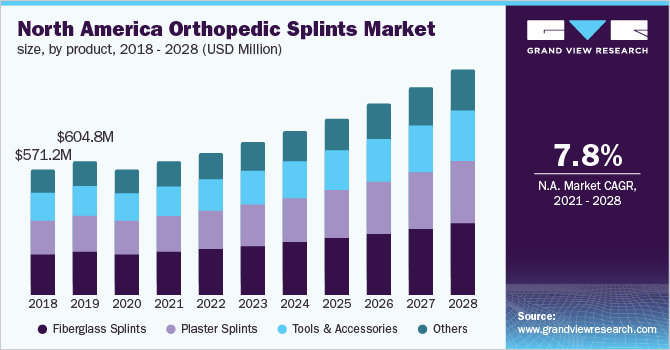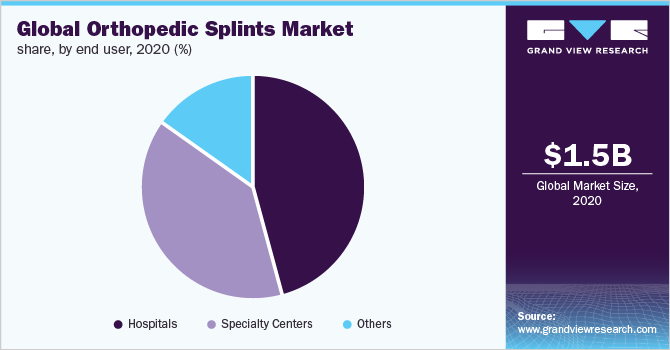- Home
- »
- Medical Devices
- »
-
Orthopedic Splints Market Size & Share Report, 2028GVR Report cover
![Orthopedic Splints Market Size, Share & Trends Report]()
Orthopedic Splints Market Size, Share & Trends Analysis Report By Product (Fiberglass, Plaster), By Application (Lower Extremity, Upper Extremity), By End User (Hospitals, Specialty Centers), And Segment Forecasts, 2021 - 2028
- Report ID: GVR-4-68039-585-9
- Number of Report Pages: 150
- Format: PDF, Horizon Databook
- Historical Range: 2016 - 2019
- Forecast Period: 2021 - 2028
- Industry: Healthcare
Report Overview
The global orthopedic splints market size was valued at USD 1.45 billion in 2020 and is expected to grow at a compound annual growth rate (CAGR) of 8.9% from 2021 to 2028. The rising cases of bone fracture and increasing geriatric population are expected to boost the market growth. Furthermore, a surge in the number of musculoskeletal disorders is also anticipated to boost the market growth. During the COVID-19 pandemic, the demand for orthopedic splints decreased owing to a decline in the number of bone fractures globally. The number of bone fracture cases decreased because of prolonged lockdowns in various countries globally. Market players also experienced a decline in their segment as well as overall revenues.

For instance, Zimmer Biomet experienced an 8.5% decline in its S.E.T segment and Essity experienced a 9.9% decline in its medical solutions segment. This resulted in a decline in the 2020’s market size. According to National Center for Biotechnology Information, as of 2020, around 1.5 million individuals suffered from a fracture caused due to bone diseases. Also, the rising geriatric population is expected to lead to more such fractures, hence driving the product demand, which fuels the market growth.
Application Insights
The lower extremity segment accounted for the maximum revenue share of around 55% in 2020. The market growth is attributed to the easy availability of these devices and the increasing prevalence of knee and hip fractures. The lower extremity segment is further divided into hip, knee, and ankle & foot. The ankle & foot segment is expected to account for the largest share, while the knee segment is estimated to grow at the fastest CAGR during the forecast period.
The upper extremity segment is expected to grow at the fastest CAGR from 2021 to 2028 owing to technological advancements in this segment and the rising incidences of shoulder and neck injuries. The upper extremity segment is further divided into elbow, hand & wrist, shoulder, and neck. The hand & wrist segment is anticipated to hold the dominant share of the market owing to rising cases of wrist fractures.
Product Insights
The fiberglass splints segment accounted for the maximum revenue share of more than 31% in 2020. The market growth is attributed to the various advantages of fiberglass splints over other types of splints. They weigh less, are more porous and durable, and hence are easy to use. Furthermore, they are a preferred choice in case the injured area needs to be X-rayed during the healing process. Moreover, it is available in various colors, which makes it a preferred alternative amongst the youth.
The plaster splint segment is anticipated to witness a significant CAGR over the forecast period. This is because it is a cheaper alternative as compared to fiberglass and other types of splints. It can also be molded into various shapes easily. Various technological advancements and high preference, especially in the rural areas of developing nations, are expected to contribute to the segment growth.
End-user Insights
The hospitals’ segment accounted for the maximum revenue share of more than 45.0% in 2020. The market growth is attributed to the high preference for hospitals in case of any injury. This trend is especially observed in developing economies. Furthermore, the rising number of hospital admissions in case of bone fractures and injuries caused by road accidents is estimated to boost the market growth.

The specialty centers segment is anticipated to witness the fastest CAGR of 9.8% from 2021 to 2028 owing to the growing awareness regarding specialty centers for the treatment of fractures and other such injuries. The others segment include ambulatory centers, clinics, trauma centers, and sports academies. This segment is also anticipated to witness significant growth during the projected period.
Regional Insights
North America accounted for the largest revenue share of around 40% in 2020. The increasing prevalence of orthopedic diseases, obesity, and geriatric population are expected to fuel the market growth during the forecast period. According to the Centers for Disease Control and Prevention (CDC), about 26% (or 78 million) of U.S. adults are estimated to suffer from arthritis by 2040.
The Asia Pacific region is expected to grow at the fastest CAGR of 10.5% from 2021 to 2028 owing to the high geriatric population in countries, such as China. This leads to high bone fracture cases, hence increasing the demand for orthopedic splints. Furthermore, Japan is also a significant contributor owing to the rising adoption of technologically advanced products in the country.
Key Companies & Market Share Insights
The global market is highly competitive and fragmented. Market players implement strategic initiatives, such as product development & launches, expansion of distribution network, and global footprint through subsidiaries and partnerships. Key players are also involved in portfolio diversification and mergers & acquisition. For instance, in November 2020, Stryker acquired Wright Medical, which strengthened its product offerings and position in a high-growth segment of lower extremity & biologics. Key players in the global orthopedic splints market include:
-
Essity
-
3M
-
Otto Bock Healthcare
-
DeRoyal Industries, Inc.
-
Medi GmbH & Co. KG
-
Zimmer Biomet
-
Stryker
-
Orthosys
-
United Medicare
-
Sam Medical
Orthopedic Splints Market Report Scope
Report Attribute
Details
The market size value in 2021
USD 1.52 billion
The revenue forecast in 2028
USD 2.76 billion
Growth rate
CAGR of 8.9% from 2021 to 2028
Base year for estimation
2020
Historical data
2016 - 2019
Forecast period
2021 - 2028
Quantitative units
Revenue in USD million/billion and CAGR from 2021 to 2028
Report coverage
Revenue forecast, company ranking, competitive landscape, growth factors, and trends
Segments covered
Product, application, end user, and region
Regions covered
North America; Europe; Asia Pacific; Latin America; MEA
Country Scope
U.S.; Canada; U.K.; Germany; Italy; France; Spain; Japan; China; India; Australia; South Korea; Brazil; Mexico; Argentina; South Africa; Saudi Arabia; Israel
Key companies profiled
Essity; 3M; Otto Bock Healthcare; DeRoyal Industries Inc.; Medi GmbH & Co. KG; Zimmer Biomet; Stryker; Orthosys; United Medicare; Sam Medical
Customization scope
Free report customization (equivalent to up to 8 analysts’ working days) with purchase. Addition or alteration to country, regional & segment scope
Pricing and purchase options
Avail of customized purchase options to meet your exact research needs. Explore purchase options
Segments Covered in the Report
This report forecasts revenue growth at the global, regional, and country levels and provides an analysis of the latest industry trends in each of the sub-segments from 2016 to 2028. For the purpose of this report, Grand View Research has segmented the global orthopedic splints market report on the basis of product, application, end-user, and region:
-
Product Outlook (Revenue, USD Million, 2016 - 2028)
-
Fiberglass Splints
-
Plaster Splints
-
Tools & Accessories
-
Others
-
-
Application Outlook (Revenue, USD Million, 2016 - 2028)
-
Lower Extremity
-
Hip
-
Knee
-
Ankle & Foot
-
-
Upper Extremity
-
Elbow
-
Hand & Wrist
-
Shoulder
-
Neck
-
-
-
End-user Outlook (Revenue, USD Million, 2016 - 2028)
-
Hospitals
-
Specialty Centers
-
Others
-
-
Regional Outlook (Revenue, USD Million, 2016 - 2028)
-
North America
-
U.S.
-
Canada
-
-
Europe
-
Germany
-
U.K.
-
France
-
Italy
-
Spain
-
-
Asia Pacific
-
China
-
India
-
Japan
-
Australia
-
South Korea
-
-
Latin America
-
Brazil
-
Mexico
-
Argentina
-
-
MEA
-
South Africa
-
Saudi Arabia
-
Israel
-
-
Frequently Asked Questions About This Report
b. The global orthopedic splints market size was estimated at USD 1.45 billion in 2020 and is expected to reach USD 1.52 billion in 2021.
b. The global orthopedic splints market is expected to grow at a compound annual growth rate of 8.9% from 2021 to 2028 to reach USD 2.76 billion by 2028.
b. North America dominated the orthopedic splints market with a share of 40% in 2020. This is attributable to increasing prevalence of orthopedic diseases, obesity, and geriatric population.
b. Some key players operating in the orthopedic splints market include Essity, 3M, Otto Bock Healthcare, DeRoyal Industries Inc., Medi GmbH & Co. KG, Zimmer Biomet, Stryker, Orthosys, United Medicare, and Sam Medical, among others.
b. Key factors that are driving the orthopedic splints market growth include rising cases of bone fracture, the surge in the number of musculoskeletal disorders, technological advancements, and an increasing geriatric population.
Share this report with your colleague or friend.
![gvr icn]()
NEED A CUSTOM REPORT?
We can customize every report - free of charge - including purchasing stand-alone sections or country-level reports, as well as offer affordable discounts for start-ups & universities. Contact us now
![Certified Icon]()
We are GDPR and CCPA compliant! Your transaction & personal information is safe and secure. For more details, please read our privacy policy.
We are committed towards customer satisfaction, and quality service.
"The quality of research they have done for us has been excellent."





